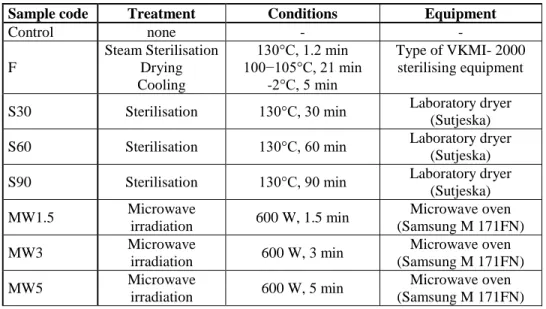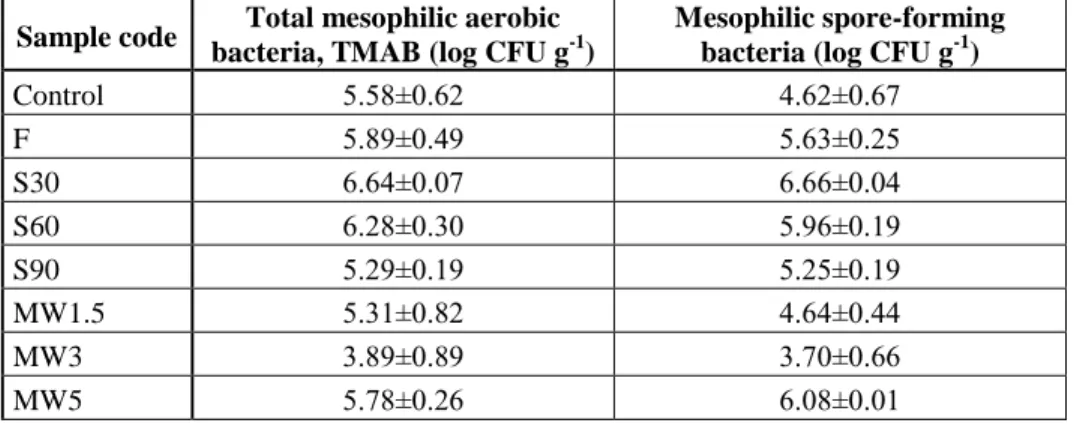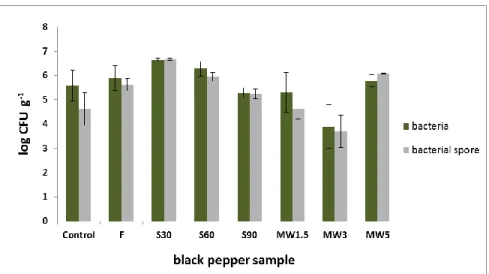BLACK PEPPER (PIPER NIGRUM L.) BACTERIAL DECONTAMINATION BY STERILIZATION AND MICROWAVE TREATMENTS
1Marijana Djordjević, 2Meta Sterniša, 2Sonja Smole Možina, 3Sándor Beszédes, 1Dragana Šoronja- Simović, 3Cecília Hodúr, 1Aleksandar Jokić, 1Zita Šereš
1University of Novi Sad, Faculty of Technology Novi Sad, Bulevar cara Lazara 1, 21000, Novi Sad, Serbia,
2University of Ljubljana, Biotechnical Faculty, Jamnikarjeva 101, 1000, Ljubljana, Slovenia,
3University of Szeged, Faculty of Engineering, Mars tér 7, H-6724, Szeged, Hungary e-mail: maridjo@tf.uns.ac.rs.
ABSTRACT
Microbial number reduction in spices through various treatments represents a necessity considering possible changes which may occur during spices’ storage and application in food resulting in public health risk. The present study was conducted in order to examine the effects of sterilisation and microwave irradiation treatments on total mesophilic aerobic bacteria (TMAB) and bacterial spore content reduction in black pepper. Treatments applied were: sterilisation at 130 °C during 30, 60 and 90 min; and microwave irradiation at a power level of 600 W during 1.5, 3, and 5 min.
Prolongation of the sterilisation treatment expressed positive influence on TMAB and bacterial spore reduction in black pepper. Compared to the sterilisation, microwave irradiation treatment exhibited better results in terms of black pepper decontamination. Maximal decontamination regarding TMAB and bacterial spore was achieved in black pepper samples treated with microwave irradiation during 3 min. The present results suggest that microwave irradiation could be applied in black pepper decontamination considering better effectiveness compared to the sterilisation treatment.
Keywords: black pepper; drying; microwave irradiation; bacterial decontamination;
1. INTRODUCTION
As the oldest and one of the most important spices valuable for its distinctive odour and flavour, pepper is the most frequently used and imported spices in the EU [1]. Despite pepper’s contribution to overall food sensorial properties, the main drawback of pepper and generally spices usage is their microbiological contamination. The contamination may occur during harvest, even drying, which often begins in small- scale farms if the proper precaution measures are not taken [2]. Although spices are non-perishable commodities, considering their low moisture contents, dry stress resistant microorganisms such as bacterial spores or some types of Salmonella still persist. The corresponding microorganisms have the ability to grow and multiply quickly to effective and toxic levels when they are introduced to a suitable environment such as water-rich food products with available nutrients. Considering this aspect, the spices addition in ready-to-eat foods represents an arising problem since these types of products are not subjected to any heat treatments [3]. Furthermore, contaminated spices addition besides product’s shelf-life shortening caused by spoilage also induced the development of foodborne illness and intoxications in several European countries [4].
Microorganisms that could be found in pepper are toxigenic moulds and yeasts as well as human pathogens such as the spore-forming Bacillus cereus, Clostridium perfringens and Salmonella [5]. Pepper’s high contamination level and high microbial load with viable counts greater than 107 CFU g-1, from which the most numerous are aforementioned spore-forming bacteria, are unfavourable leading to significant problems in export [6]. Commonly used treatments for the microorganisms’ inactivation in pepper are steam sterilisation, gamma irradiation and fumigation with ethylene oxide [7]. Steam sterilisation requires an additional drying step mining additional energy and potential recontamination of the product as well as possible colour and aroma deterioration and volatile compounds content reduction. Regarding efficiency, fumigation and gamma irradiation are more efficient compared to steam sterilization especially in spices with a high microbial load like pepper [8]. However, considering carcinogen residues formation fumigation with ethylene oxide is suppressed by European Union law while gamma irradiation requires higher initial
investment and safety measures and is accompanied by consumers’ mistrust [8]. To overcome the aforementioned technics’ drawbacks and address the present-day demands in the quick sterilisation process development, without any post-treatment step required, and possible application on ‘in-pack’ products microwave treatment should be considered.
Microwave is an electromagnetic wave with a wave- length ranging from 1 mm to 1 m and operating in the frequency range of 300–30000 MHz [9]. In food processing microwave energy is used mainly for its heating properties. The conversion of microwave energy into heat in food occurs mainly due to water presence as a consequence of dipole water molecules rotation with respect to changing electric field with frictional heat production as an outcome. The quick absorption of energy by water molecules causes rapid water evaporation resulting in high food drying rates [10]. Microwaves penetrate directly into the material inducing volumetric heating (from inside out) and providing fast and uniform heating throughout the product. Therefore the main advantages of microwave drying over the conventional drying are warm up time reduction and preservation of the product’s natural organoleptic characteristics [11]. Furthermore, due to the convenience and ease handling, microwaves application in spices processing is gaining the research community attention.
The objective of this study was to investigate the antibacterial effect of sterilization and microwave irradiation on the bacteria and bacterial spore reduction in black pepper seed.
2. MATERIALS AND METHODS 2.1. Materials
Black pepper (Piper nigrum L.) seed before all treatments was purchased from Geneza Ltd., Kanjiza, Serbia and stored at 8±1°C until further use.
2.2. Sterilization and microwave irradiation treatments
A laboratory dryer (Sutjeska) was used to investigate the effect of sterilisation on the bacterial decontamination of black pepper. The sterilization treatment was conducted on 10 g of black pepper placed on a Petri dish in a single layer at 130 °C during three different time periods (30 min, 60 min, 90 min) (Tab. 1).
Table 1. Applied black pepper treatments and corresponding conditions Sample code Treatment Conditions Equipment
Control none - -
F
Steam Sterilisation Drying Cooling
130°C, 1.2 min 100−105°C, 21 min
-2°C, 5 min
Type of VKMI- 2000 sterilising equipment
S30 Sterilisation 130°C, 30 min Laboratory dryer
(Sutjeska)
S60 Sterilisation 130°C, 60 min Laboratory dryer
(Sutjeska)
S90 Sterilisation 130°C, 90 min Laboratory dryer
(Sutjeska)
MW1.5 Microwave
irradiation 600 W, 1.5 min Microwave oven (Samsung M 171FN)
MW3 Microwave
irradiation 600 W, 3 min Microwave oven (Samsung M 171FN)
MW5 Microwave
irradiation 600 W, 5 min Microwave oven (Samsung M 171FN)
Dried samples were allowed to cool to room temperature, packed and used for further microbiological analysis. To investigate the effects of microwave irradiation on the bacterial decontamination of black pepper a domestic microwave oven (Samsung M 171FN) was used. For the treatment, 10 g of black pepper was placed on a Petri dish in a single layer and located at the centre of turntable plate. Samples were exposed to microwave at a power level of 600 W and three different time periods (1.5 min, 3 min, 5 min) (Tab. 1). After microwave treatment, treated samples were allowed to cool to room temperature, packed and used for further microbiological analysis.
2.3. Microbiological analysis
The effects of sterilization and microwave irradiation on the bacterial decontamination were evaluated through total plate counts of total mesophilic aerobic bacteria (TMAB) and bacterial spore content of black pepper. Following the sterilization and microwave drying treatments, pepper was aseptically sampled, to exclude subsequent contamination and obtain a realistic insight into the effect of treatment (steam sterilization, sterilization and microwave irradiation) on the present microflora. The sample of pepper after the treatment was placed in a test tube with sterile 0.9% saline solution and homogenized by stirring. The heat treatment in a water bath at 80°C for 10 min was conducted for the wash solution in order to isolate and count the mesophilic spore-forming bacteria. The wash solution was then sequentially diluted (1:10) placed on a plate count agar (PCA, Merck) and incubated at 30°C for 72 h for both TMAB and mesophilic spore-forming bacteria [12]. Colonies of the appeared bacteria were counted and calculated according to the equation (1):
𝑁 = 𝑐
(𝑛1+ 0.1 × 𝑛2) × 𝑅 (1)
where c represents the sum of all colonies, n1 represents the number of parallels at first countable dilution, n2 represents the number of parallels at second countable dilution, and R represents dilution factor of first countable dilution. Microbial enumerations were expressed as log of colony forming unit per gram of sample (CFU g-1).
3. RESULTS AND DISCUSSION
The results addressing the sterilisation and microwave treatments efficiency in bacteria and bacterial spore decontamination are presented in Tab. 2 and graphically illustrated in Fig. 1.
Table 2. Bacteria and bacterial spore number in black pepper samples after sterilisation treatment during 30, 60, and 90 min (S30, S60, S90) and microwave treatment during 1.5, 3, and 5 min (MW1.5, MW3, MW5)
Sample code Total mesophilic aerobic bacteria, TMAB (log CFU g-1)
Mesophilic spore-forming bacteria (log CFU g-1)
Control 5.58±0.62 4.62±0.67
F 5.89±0.49 5.63±0.25
S30 6.64±0.07 6.66±0.04
S60 6.28±0.30 5.96±0.19
S90 5.29±0.19 5.25±0.19
MW1.5 5.31±0.82 4.64±0.44
MW3 3.89±0.89 3.70±0.66
MW5 5.78±0.26 6.08±0.01
The number of TMAB expressed as log of colony forming unit per gram of sample for sterilised and microwave irradiated samples was found to be in the range of 5.29 to 6.64, and 3.89 to 5.78, respectively.
An increase in the number of TMAB was observed in samples sterilised during 30 and 60 min (samples S30, S60, Tab. 2) compared to control. probably due to too short time of treatment and smaller reduction of water content inside pepper. Conversely, a decrease in the number of TMAB was detected with the treatment period prolongation to 90 min (Tab. 2, Fig. 1), indicating time of treatment as an important factor in dry sterilization. Considering microwave irradiation treatment, a decrease in the number of TMAB was noted for samples treated during 1.5 and 3 min compared to control and sample sterilized by steam in the factory. Furthermore, prolongation of the microwave irradiation treatment from 1.5 to 3 min induced a decrease in TMAB number for 26% (samples MW 1.5 and MW3, Tab. 2). Similar observation on TMAB number decrease with prolonged exposure time to microwave irradiation was previously reported in literature [7]. However, further prolongation of the microwave irradiation to 5 min induced an increase in TMAB number. A decrease in TMAB number was more pronounced in microwave irradiated black pepper samples compared to sterilized samples.
Figure 1. The effects of sterilisation and microwave irradiation treatments on pepper bacterial decontamination. For sample code see Tab. 1.
The bacterial spore number expressed as log of colony forming unit per gram of sample was found to be lower compared to TMAB number in most black pepper samples regardless of applied treatments (Tab. 2, Fig. 1). For sterilized black pepper samples bacterial spore number ranged from 5.24 to 6.66 log CFU g-1. Compared to the control sample, an increase in bacterial spore number was noted in sterilized black pepper samples. However, a decrease in bacterial spore number was observed with sterilisation treatment period prolongation from 30 to 90 min (Tab. 2). As regards to microwave irradiation treatment, bacterial spore number in black pepper samples ranged from 3.70 to 6.08 log CFU g-1. The bacterial spore number in samples exposed to microwave irradiation for 1.5 and 5 min (samples MW1.5, MW5, Tab. 2) was higher compared to the control sample. Conversely, the lowest bacterial spore number was found in sample treated with microwave irradiation during 3 min. The corresponding sample had bacterial spore number 19% lower than control. Prolongation of microwave irradiation to 5 min led to an increase in bacterial spore number. Comparing the treatments applied, microwave irradiation was more effective in bacterial spore number reduction.
4. CONCLUSIONS
The present study investigated the effects of sterilisation and microwave irradiation on bacteria and bacterial spore decontamination in black pepper. Sterilisation treatment at 130 °C during 90 min was the most efficient regarding total mesophilic aerobic bacteria and bacterial spore decontamination considering investigated sterilisation treatments. In general, microwave irradiation treatment proved to be more efficient regarding bacteria and bacterial spore decontamination compared to sterilisation. In black pepper samples treated with microwave irradiation during 3 min maximal decontamination regarding total mesophilic aerobic bacteria and bacterial spore was achieved. However, further prolongation of the microwave irradiation treatment resulted in microbial picture deterioration. The present study showed the greater potential of microwave irradiation treatment in bacteria and bacterial spore decontamination compared to sterilisation. Although further research is needed to establish optimal treatment condition for achieving maximal microbial decontamination, microwave irradiation represents a promising technic for the microbial number reduction in spices.
ACKNOWLEDGMENT
This study is supported by Project of the Provincial Secretariat of Vojvodina for Higher Education and Scientific Research (Project no. 142-451-2445/2018). The authors would like to thank Szabó Tamás MSc and to Geneza Ltd., Kanjiža, Serbia, for technical-technological help and for purchasing the row material as well.
REFERENCES
[1] CBI. The spice and herbs market in the EU, (2010).
[2] S. E. Keller, J. M. VanDoren, E. M. Grasso, L. A. Halik, Growth and survival of Salmonella in ground black pepper (Piper nigrum), Food Microbiology, 34 (2013), pp. 182-188.
[3] C. Little, R. Omotoye, R. Mitchell, The microbiological quality of ready-to- eat foods with added spices, International Journal of Environmental Health Research, 13(1) (2003), pp. 31-42.
[4] H. J. Buckenhuskes, M. Rendlen, Hygienic problems of phytogenic raw materials for food production with special emphasis to herbs and spices. Food Science and Biotechnology, 13 (2004), pp. 262-268.
[5] A. C. Ristori, M. A. S .Pereira, D. S. Gelli, Behavior of Salmonella Rubislaw on ground black pepper (Piper nigrum L.), Food Control, 18(3) (2007), pp. 268–272.
[6] J. Piggott, Z. Othman, Effect of irradiation on volatile oils of black pepper, Food Chemistry, 46(2) (1993), pp. 115-119.
[7] G. C. Jeevitha, H. B. Sowbhagya, H. U. Hebbar, Application of microwaves for microbial load reduction in black pepper (Piper nigrum L.), Journal of The Science of Food and Agriculture, 96 (2016), pp. 4243–4249.
[8] U. Schweiggert, R. Carle, A. Schieber, Conventional and alternative processes for spice production - a review, Trends in Food Science & Technology, 18(5) (2007), pp. 260-268.
[9] R. V. Decareau, Microwaves in the Food Processing Industry, Academic Press, Inc., New York, 1985 [10] M. Bouraoui, P. Richard, T. Durance, Microwave and convective drying of potato slices, Journal of
Food Process Engineering, 17 (1994), pp. 353–363.
[11] J. Canumir, J. Celis, J. Bruijn, L. Vidal, Pasteurisation of Apple Juice by Using Microwaves, LWT - Food Science and Technology, 35 (2002), pp. 389-392.
[12] ISO 4833-2. Microbiology of the food chain -- Horizontal method for the enumeration of microorganisms -- Part 2: Colony count at 30 degrees C by the surface plating technique (2013)


